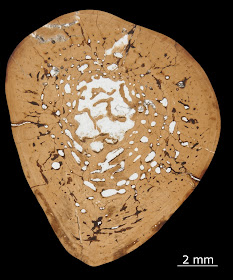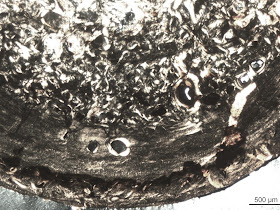 |
| This is the femur of Metoposaurus diagnosticus krasiejowensis as viewed from behind (posterior). The sectioned plane is marked by the white stripe [Credit: Georg Oleschinski] |
The broad, flat head, broad flat arm bones, wide hands, and large tail of Metaposaurus diagnosticus led the investigators to conclude that this species swam in ephemeral lakes during the wet season and used its broad, flat head and forearms to burrow under the ground when the dry season began. The authors also examined cross-sections of the bones of Metoposaurus looking for growth rings, called annuli. These annuli are similar to tree rings, where a band of light and a band of dark indicate one year of growth.
 |
| This image shows microanatomy of the midshaft of Metoposaurus femur [Credit: Georg Oleschinski] |
Dr. Michel Laurin from the Museum National d'Histoire Naturelle who was not involved with this study, commented, "This interpretation is interesting, but problematic in some respects. This animal was much larger than any extant burrowing species I know of, and if it dug, I suspect that the snout and tail played a far greater role than the limbs, as we observe in most extant aquatic vertebrates."
These annuli also give an estimate of age. Co-author P. Martin Sander said, "A common problem with these large amphibians is that you can't tell from the shape of their bones if they are grown or not; sometimes the youngsters get described as a different species from the grown-ups." This technique solves that problem. It turns out that all of the specimens preserved at Krasiejow were juveniles. The smallest specimen was only one year old, while the largest specimen was four. Adulthood in these large amphibians was usually reached around year seven. The authors do not know if this mode of life was unique to juveniles or if adults also burrowed.
Sander concludes, "It amazes me time and again how much we can learn from these extinct animals. The techniques we used have been around since the 1840s, but only in the last 20 years have researchers asked the right questions and drawn comparisons with living animals."


No comments:
Post a Comment